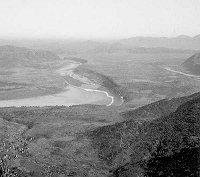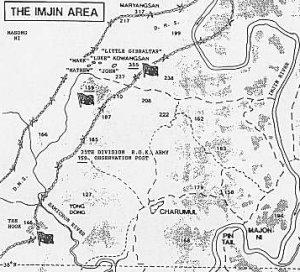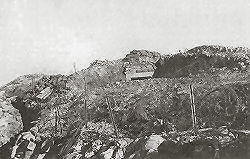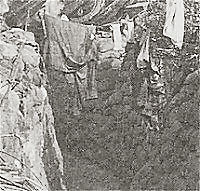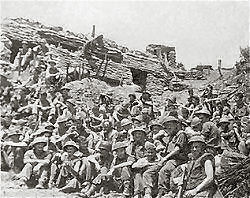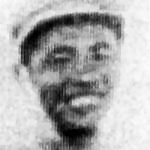I served with 2Btn as an ordinary private in the Australian Army, initially as a reinforcement replacement from our holding unit in Japan. My Service number was 2 / 401368 and I was a member of "D" Company 2RAR. I first saw action on hill 159 and later on the "Hook".
| ANNECDOTES |
| My Story Memories Fraternization With The Enemy Aussie sense of humour |
MY STORY
2/401368 Keith H. Hasler, "D" Company 2RAR
I can very clearly recall the night I arrived at the 2Btn positions on Hil1 159, a small knoll alongside Hi11 355 (or Little Gibraltar as it was known by some). Hill 159 was on the southern side of the Samichon river, (small creek would be more of an apt name) and being night time, I was to say the least, in the dark as to which way lay the enemy (Chinese) forces.
We had been flown by an Australian Air Force Dakota (DC3) from Iwakuni in Japan not very far from our unit base at Hiro Barracks, a stones throw from Kure Naval Base. From Kimpo Airfield, it was an Australian Army truck ride through what was left of Seoul and up to our front line positions. For memory, there were six or seven of us with different units to go to, some to the Companies of 3Btn and some to the Companies of 2Btn. My mate and friend from South Australia, Peter Crowe, had been marked down for "D" Company 2Btn, and so, at days end, we found ourselves being introduced by an accompanying NCO to the section leader and Company Commander and his group of Non Commissioned Officers, (NCO's) with ranks from Lance Corporal, (one chevron or stripe) Corporals (two stripes) and finally, our Company Sergeant (3 stripes).
We were shown to what was to be our "home" for the next few weeks, a dugout leading from a communication trench, furnished with a couple of bunks made from a maze of wire and kept suspended off the ground by steel pickets, very basic and totally unlike anything we had so far encountered in our short (10 month) Army career. I can recall saying to the NCO who showed Peter and I this "luxurious" `hootchie' as they would be referred to from now on, "There's water laying about on the floor mate, what do we do about that?" His reply was the epitome of Australian humour. He simply replied, "Rent's extra with running water!"
I can remember writing to my family and saying something along the lines of ..."well at last I'm here, my big adventure has started and I'm looking forward to my first patrol in the coming days..." I was just so gung ho!
Day one dawned and after a hot breakfast, prepared by our own Company cooks in a sheltered area somewhere to our rear, we began our briefing sessions on what was to be our night time patrol duties. I had completed a signal course back in Australia while killing time prior to embarkation, and so I was reminded of this and told that I would be carrying a portable radio on our journey into the valley this first night. I immediately protested, saying that I had forgotten all I had learnt about Radio Procedure, but silently thinking to myself that a radio on one's back could not double for any sort of protective weapon. I was then told, "That's OK, you can carry the Bren Gun." (A British light machine gun, with a capacity of some 32 rounds in a removable magazine, firing .303 ammunition in either single rounds or automatic, similar to a US BAR.)
At last light, the patrol, which was called a "stand-by patrol" moved out into the valley below. We were only required to stand by in case a forward patrol got into difficulties in which case, we would go to their assistance. In single file and total silence, we set up position on either side of an obvious trail, guarded further by the location of mine fields on either side of our position. The night was warm, the mosquitos quite plentiful as we lay concealed with the only sound apart from the ever sounds of gun-fire, the occasional slap of hands against the skin to squash a mozzie and the associated curse, to which a quiet command would say.. "Shut up you blokes".
An uneventful night slowly passed into early morning and as we grew tired, an awful feeling of imagination crept into our dull minds. We started to imagine that bushes moved, that charlie, (the Chinese) were surrounding us, I even imagined that I could smell him, when suddenly to my flank I did see movement. I distinguished the outline of a human form. I thought to myself, "Nobody is going to creep up on me and slit my throat!" So I slowly released the safety on my Bren, signalled to Peter my intentions, and began to raise the Bren and squeeze the trigger. At that precise moment, somebody fired a flare into the air, the Allies, or the Chinese, it didn't matter, for in that split second I recognised Max Conway staring into space, quite oblivious of the fact that I came within a whisker of destroying Max in a hail of gun-fire.
From then on I have learnt a valuable lesson, not to jump to conclusions, and more valuable than anything is the fact that Max was not killed that first night on patrol and we both lived to relate this tale to our kin.
One night I can recall was when our patrol was to act as an ambush patrol. This meant that a fighter patrol had gone before us looking for signs of enemy activity and when found, was to discreetly return through our "trap" when we could engage the "pursuing" Chinese. But, instead of simply drawing the enemy back into the "trap", the patrol had itself been attacked by a far superior number of Chinese soldiers and was itself pursued back through our group. As the shooting came closer and our own troops appeared, the firing became intense, not only from the obvious position of the pursuing Chinese, but also from the Chinese fixed positions on the other side of the valley.
Our orders were to "retreat immediately"! and this we did, but not before I emptied a couple of magazines in the general direction of the attackers.
By this time all around me had started to climb the steep slope to our own lines, and so on that night along with twenty or so others, I ran for my life, while all around us we could hear the ominous thud, thud of bullets striking the surrounding ground, along with the many whump, whump sounds of exploding Chinese mortars directed onto our escape route. We made our escape to the safety of our trenches and weapon pits while all around us rained the most intense bombardment I had witnessed so far.
For memory it probably only lasted a few minutes, but at the time, seemed like an eternity, and miraculously we discovered after it was all over, not one drop of blood had been spilled by either group. How that can be explained remains a mystery to me to this day.
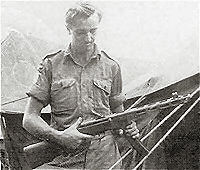 | Keith H. Hasler New South Wales AUSTRALIA 18/03/00 |
|
|
